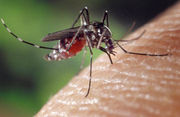Are you wondering how those pesky mosquitoes find hosts to victimize? Results of flight tunnel studies on the mosquito Aedes aegypti, the vector of dengue fever virus, revealed that carbon dioxide detected as turbulent plume leads to more directed flight upwind by the pest. A plume of this gas that is fluctuating in concentration and mimicking the presence of a live host elicited the best response.
Carbon dioxide alone, without host odor, is enough to induce directed flight toward the source. This first encounter with the gas is also necessary to “prime” the mosquito to respond to human skin odor. A broad plume of human skin odor of unvarying intensity is the best cue for the mosquito that food is very close.
Only female mosquitoes feed on blood, which they need to produce eggs. In contrast, male mosquitoes feed only on nectar and plant juices and would therefore not need these cues from animals.
Find out more about the results of this study and the entomologists behind it by clicking this link. The full scientific article can be access from the Journal of Experimental Biology.
These research findings may lead to more effective mosquito control measures through improved mosquito trap designs or better ways to make humans “invincible” to the pest.
Learn about Bio-Tech Environmental’s Dengue Vector Control project with De La Salle College of Saint Benilde.
Tagged with: mosquito • pest-borne disease • research • scientific • vector control
Like this post? Subscribe to my RSS feed and get loads more!








Leave a Reply